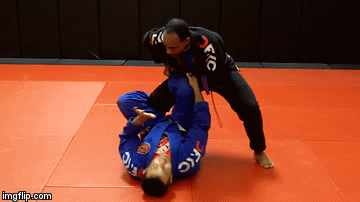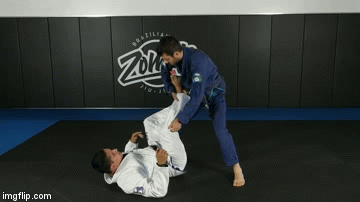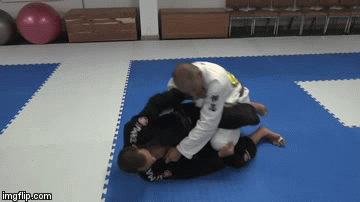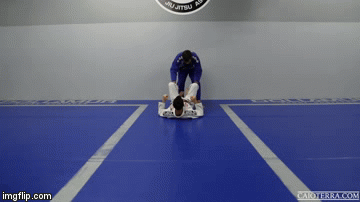
Certain BJJ techniques strike fear in the hearts of even the most experienced grapplers. Amongst those that can terrify anyone, guard passes rank higher than any other technique. Pressure passes, in particular, are the stuff of nightmares for anyone involved in grappling. Take the leg drag pass for example. If you’ve ever experienced a top-level leg dragger passing your guard, you know what I mean. You get twisted up, you’re under immense pressure and all you can think about is letting the guy/girl pass, even at the price of giving away back control. When you’re all packed up in a tight leg drag, you only want it to end, and you’re not thinking about leg drag counters or defending. Well, it’s about time you do something to change this approach.
First of all, you need to make the distinction between guard retention and guard pass counters. Retention means you’re still in guard while countering a pass means your opponent has superior positioning. That merits the use of concep[ts over singular techniques if you are to have any hope at avoiding the pass. The basic concept includes guard retention as the first line of defense, though. Moreover, you need to understand guard passing and leg drag in particular. leg drag counters are only going to work if you know all the phases of the pass, and when you should react.
The Fundamentals of Guard Retention
Guard retention is all about recognizing danger. When you establish a good guard position, staying in it should be your primary concern. Only when you’re certain you have a perfect structure, you can think about going into attack mode. Guard retention means that your opponent can’t find a way past your guard, no matter what they do. To make everything abundantly clear, if the opponent manages to get into a passing position, your guard retention failed.
Once you know that your opponent is passed one of your guard’s layers, you need to think about getting back the proposition. At this point, only guard recovery matters. This is the point of pass prevention. As far as leg drag counters go, this is the most important time to act. Preventing the leg drag before the opponent sets in is the highest percentage counter you can do.
Finally, the best thing to do if your opponent is pat a few of your guard’s layers is to disengage. There’s a point of no return when you’re trying to recover guard. If you go past this point, anything you’re doing is going to have a low chance of success. the best bet is to completely disengage with the opponent and try your luck from a neutral position, instead of a very bad one.
Yet, sometimes you’ll end up in a bad spot, like the leg drag, regardless of your prevention attempts. this is where leg drag counters come into play. They are the final layer of defense.
The Leg Drag Pass
before we get into specific leg drag counters, let’s take a short look at the leg drag pass. The Leg drag is such a powerful pass because it combines pressure with pinning. This is the main issue of leg drag. It places you in a position where your body is not only pinned, but your opponent also has a great angle to place immense pressure on you. Furthermore, they can stay in the position indefinitely, unless you know precisely what you need to do.
The pin in a leg drag pass comes as a result of your body positioning. the main reason this pass is such a successful one is that it isolates your upper and lower body in different directions. While the hips and legs of your opponent keep your knees twisted in one direction, they can use their upper body to pin your torso to the ground, usually in the opposite direction. the spinal twist means your ability to move is virtually not nonexistent.
As if that’s not enough, the opponent can place all their weight on top of you, while using their arms and head to completely immobilize your torso. From there, they can play a waiting game, crushing you slowly with every passing moment until you give up the position.
Leg Drag Counters
Now that you understand the concept and layers of guard retention and recovery and you know the main dangers of leg drag, it’s time to think about leg drag counters. As such, you should know that there aren’t many ways in which you can counter this pass. Even amongst those that exist, only a handful are truly effective against high-level opponents.
As with every defense, we’ll start with how to prevent the leg drag pass. Next up, we’ll explore a couple of very effective counters. One of them is actually a real game-changer, as it’ll get you on the opponent’s back or in a leg drag pass yourself. Finally, before we go into the submission counter to the leg drag pass, we’ll go over some key drills for practicing leg drag counters.
Prevention

Inverted Escape

This not only prevents the leg drag but also gets you in the perfect position to invert. As you do, you must place both hooks behind their knees as soon as possible. From there, you can go into any attack you want, from back takes, to playing guard and even leg locks.
To The Back / Leg Drag
This is the most efficient of the leg drag counters, provided you can execute it. It is not one for beginners, as it does involve some advanced transitioning skills. however, the beginning part of it, with the leg hook, is something you can base most of your leg drag counters on.

Drilling Leg Drag Counters

Outside Ashi Garami
Finally, the most offensive counterattack is actually the one that’s a real last-ditch defense. When your opponent has the leg drag all setup, the only hope you have is retracting your leg so that you can place it on their hip. From there, you’ll do the same with the outside leg so that you have a strong structure that can push. The goal is to push their hips back. That way that you can break them down to the ground and get into the outside Ashi Garami.
If you want to truly master this counter, make sure you pick up Eddie Cummings’ “Ashi Garami Seminar” DVD. It features a lot of counter-attacking moves involving leg locks, and the “Wolverine” is a proven authority in the field.
Eddie Cummings Seminar on Ashi Garami & Awesome Heel Hook Escape


![Darce Choke Encyclopedia – Origins, Mechanics and Variations [2025] BJJ, choke, Brabo, BJJ Darce Choke, D'arce Choke, Darce BJJ Choke](https://bjj-world.com/wp-content/uploads/2017/11/JungPoirierLeeYahoo-218x150.jpg)









![X-Guard Trickery Kyle Sleeman DVD Review [2025] X-Guard Trickery Kyle Sleeman DVD Review](https://bjj-world.com/wp-content/uploads/2025/03/x-guard-trickery-kyle-sleeman-dvd-review-218x150.png)
![Countering with Crab Ride Anthony Budion DVD Review [2025] Countering with Crab Ride Anthony Budion DVD Review](https://bjj-world.com/wp-content/uploads/2025/03/countering-with-crab-ride-anthony-budion-dvd-review-218x150.png)
![Closet Closed Guard Craig Jones DVD Review [2025] Closet Closed Guard Craig Jones DVD Review](https://bjj-world.com/wp-content/uploads/2025/03/closet-closed-guard-craig-jones-dvd-review-218x150.png)
![Xanadu Back Takes Levi Jones-Leary DVD Review [2025] Xanadu Back Takes Levi Jones-Leary DVD Review](https://bjj-world.com/wp-content/uploads/2025/03/xanadu-back-takes-levi-jones-leary-dvd-review-218x150.png)

![No-Gi Grapplers Guide To Front Headlock Joel Bane DVD Review [2025] No-Gi Grapplers Guide To Front Headlock Joel Bane DVD Review](https://bjj-world.com/wp-content/uploads/2025/03/no-gi-front-headlock-joel-bane-dvd-review-218x150.png)

![Wrestling For Jiu-Jitsu Shawn Williams DVD Review [2025] Wrestling For Jiu-Jitsu Shawn Williams DVD Review](https://bjj-world.com/wp-content/uploads/2025/01/wrestling-for-jiu-jitsu-shawn-williams-dvd-review-100x70.png)
![Higher Tripod Passing Craig Jones DVD Review [2025] Higher Tripod Passing Craig Jones DVD Review](https://bjj-world.com/wp-content/uploads/2025/02/higher-tripod-passing-craig-jones-dvd-review-100x70.png)


![No-Gi Open Guard K-Guard Lachlan Giles DVD Review [2024] No-Gi Open Guard K-Guard Lachlan Giles DVD Review](https://bjj-world.com/wp-content/uploads/2024/12/no-gi-open-guard-k-guard-lachlan-giles-dvd-review-100x70.png)
![Upper Body Chain Attacks Janine Mocaiber DVD Review [2025] Upper Body Chain Attacks Janine Mocaiber DVD Review](https://bjj-world.com/wp-content/uploads/2025/03/upper-body-chain-attacks-janine-mocaiber-dvd-review-100x70.png)
![Master Scissor Sweep Ryan Scialoia DVD Review [2025] Master Scissor Sweep Ryan Scialoia DVD Review](https://bjj-world.com/wp-content/uploads/2024/12/scissor-sweep-ryan-scialoia-dvd-review-100x70.png)
![Daisy Fresh WHITE BELT Wrestling Curriculum DVD Review [2024] Daisy Fresh WHITE BELT Wrestling Curriculum DVD Review](https://bjj-world.com/wp-content/uploads/2024/10/daisy-fresh-white-belt-wrestling-curriculum-review-100x70.png)
![The Stack Pass Andre Galvao DVD Review [2025] The Stack Pass Andre Galvao DVD Review](https://bjj-world.com/wp-content/uploads/2025/01/the-stack-pass-andre-galvao-dvd-review-100x70.png)
![Wristlocks From The Top Pete Letsos DVD Review [2025] Wristlocks From The Top Pete Letsos DVD Review](https://bjj-world.com/wp-content/uploads/2025/01/wristlocks-from-the-top-pete-letsos-dvd-review-100x70.png)

![Breaking Their Guard Mikey Musumeci DVD Review [2025] Breaking Their Guard Mikey Musumeci DVD Review](https://bjj-world.com/wp-content/uploads/2025/02/breaking-their-guard-mikey-musumeci-dvd-review-100x70.png)

![Forging The De La Riva Guard Giancarlo Bodoni DVD Review [2025]](https://bjj-world.com/wp-content/uploads/2025/02/de-la-riva-guard-giancarlo-bodoni-dvd-review-100x70.png)

![Highlight Hip Throws Christian Ozbek DVD Review [2025] Highlight Hip Throws Christian Ozbek DVD Review](https://bjj-world.com/wp-content/uploads/2025/01/highlight-hip-throws-christian-ozbek-dvd-review-100x70.png)


![Dynamic Headquarters Passing Jason Rau DVD Review [2024] Dynamic Headquarters Passing Jason Rau DVD Review](https://bjj-world.com/wp-content/uploads/2024/10/dynamic-headquarters-passing-jason-rau-dvd-review-100x70.png)

![Complete Fundamentals Curriculum Eliot Marshall DVD Review [2025] Complete Fundamentals Curriculum Eliot Marshall DVD Review](https://bjj-world.com/wp-content/uploads/2025/02/fundamentals-curriculum-eliot-marshall-dvd-review-100x70.png)
![Just Pass Jay Rodriguez DVD Review [2024] Just Pass Jay Rodriguez DVD Review](https://bjj-world.com/wp-content/uploads/2024/11/just-pass-jay-rodriguez-dvd-review-100x70.png)
![Xanadu Back Takes Levi Jones-Leary DVD Review [2025] Xanadu Back Takes Levi Jones-Leary DVD Review](https://bjj-world.com/wp-content/uploads/2025/03/xanadu-back-takes-levi-jones-leary-dvd-review-100x70.png)

![No-Gi Grapplers Guide To Front Headlock Joel Bane DVD Review [2025] No-Gi Grapplers Guide To Front Headlock Joel Bane DVD Review](https://bjj-world.com/wp-content/uploads/2025/03/no-gi-front-headlock-joel-bane-dvd-review-100x70.png)
![10th Planet Leg Locks Jeremiah Vance DVD Review [2025] 10th Planet Leg Locks Jeremiah Vance DVD Review](https://bjj-world.com/wp-content/uploads/2025/01/10th-planet-leg-locks-jeremiah-vance-dvd-review-100x70.png)
![Modern Split Squat Passing Jason Rau DVD Review [2024] Modern Split Squat Passing Jason Rau DVD Review](https://bjj-world.com/wp-content/uploads/2024/11/modern-split-squat-passing-jason-rau-dvd-review-100x70.png)
![Best Marcelo Garcia Techniques by Team Marcelo Garcia DVD Review [2025] Best Marcelo Garcia Techniques by Team Marcelo Garcia DVD Review](https://bjj-world.com/wp-content/uploads/2025/02/best-marcelo-garcia-techniques-dvd-review-100x70.png)